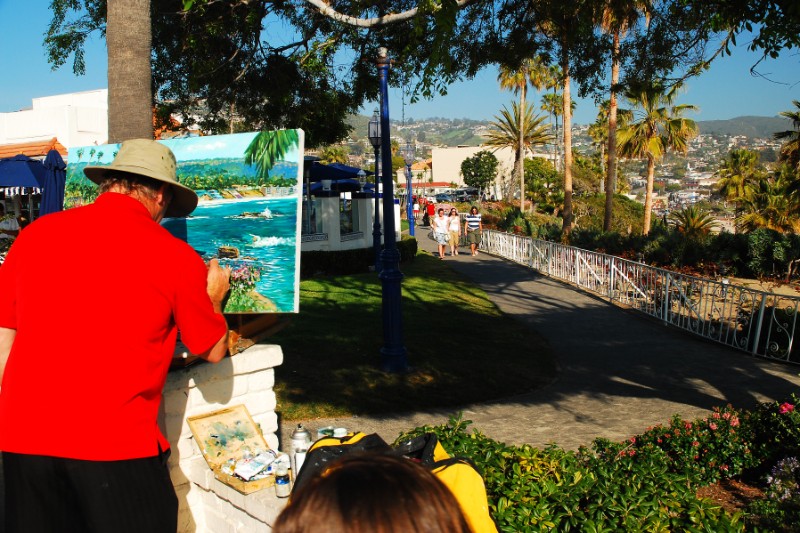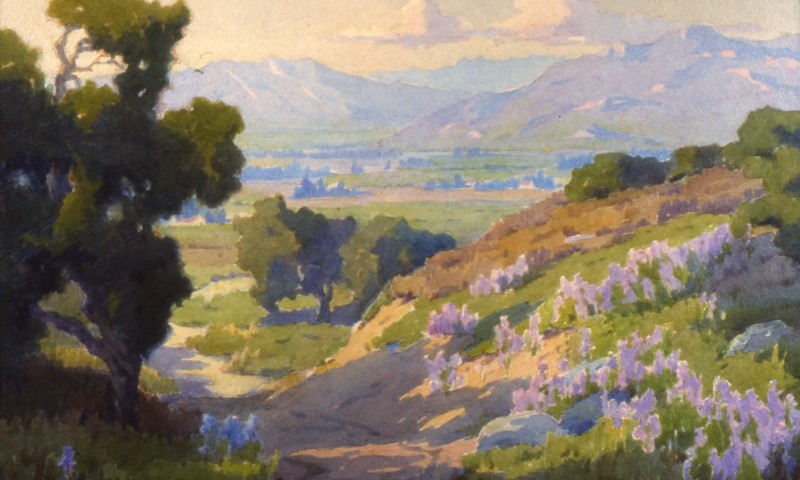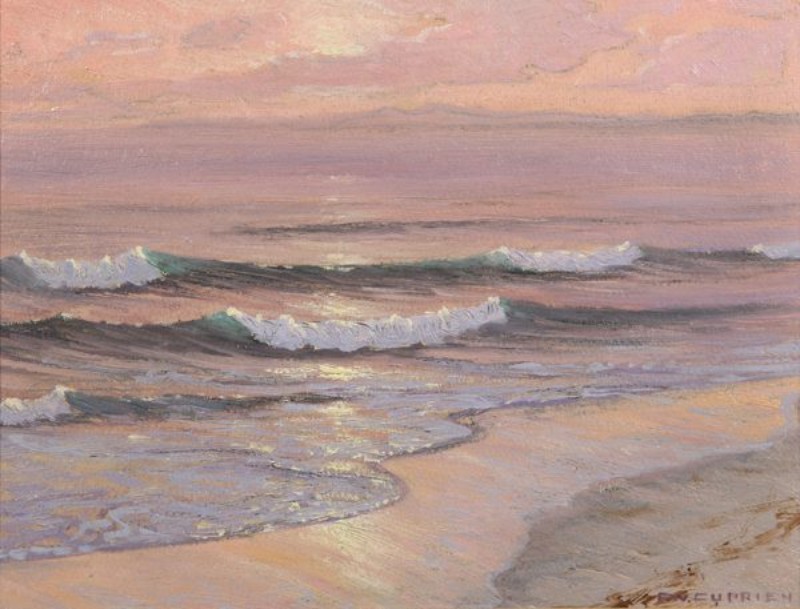
Table of Contents
Since the early 20th century, famous Laguna Beach artists have been immortalizing the natural beauty of Laguna Beach. They come to admire the city’s rolling hills, majestic coastal bluffs, and the ever-changing colors of the ocean, then try to capture what they saw on canvas or film. Continue reading to learn more about Laguna Beach’s famous artists and how the city came to be known as a beloved artists’ colony.
PRIDE & JOY: THE FAMOUS ARTISTS OF LAGUNA BEACH
There are many prominent artists who have called Laguna Beach home in the last hundred years. The first wave was composed of plein-air (outdoor painting) artists, who were drawn to the light and the landscape said to be seen only on the unspoiled coastline of Laguna Beach. Soon after, other artists followed suit, turning Laguna Beach into a colony for creative and artistic types.
Here is a peek into the lives and works of some of Laguna Beach’s most prolific painters.
-
Roger Kuntz
Roger Edward Kuntz (1926-1975) is one of the most prolific and recognized among the famous Laguna Beach artists. He was a figurative and later modernist artist who transformed natural surroundings into striking oil and watercolor paintings. Described as a Renaissance Man, Kuntz was a highly intelligent individual who also pursued teaching, fishing, sculpting, crafting, and music.
Kuntz originally hailed from Texas and later moved to Lomaland, California with his mother and brother following his father’s passing. He studied at nearby Pomona College and earned his Master of Fine Arts degree at Claremont Graduate University. Early in his career, Kuntz won several competitions and solo exhibitions in both local and international museums, including the Fine Arts Gallery of San Diego, the Pennsylvania Academy of Fine Arts, and the São Paulo Art Biennial.
In 1963, Kuntz moved his family to Laguna Beach. There, he painted a series of works that focused on the region’s iconic coastal and urban environments. His most notable contributions were his paintings of freeways, overpasses, and other elements of the built environment, which were part of his larger “Freeway Series.” It included his oil paintings Freeway Shadow (1960) and Concrete Canyon.
While Kuntz is not widely recognized for traditional coastal scenes or landscapes typical of Laguna Beach, his paintings reflect the changing Southern California environment during the postwar era. His work is celebrated for its modernist approach, capturing the region’s evolving identity and the intersection of nature and urbanization.
-
Anna Hills
Anna Althea Hills (1882 – 1930) was a highly accomplished and influential Laguna Beach artist. Her early work was centered on European academic style, with figures and genre as her main subjects. She studied at the Olivet University in Michigan, School of the Art Institute of Chicago, and Académie Julian in Paris. Hills traveled across England and Holland, before finally settling in Laguna Beach.
As a Laguna Beach resident, Hills was very active in her community. She was a founding member of the Laguna Beach Art Association and spearheaded funding efforts to build a gallery, The Laguna Beach Art Association Gallery, which now stands as the Laguna Art Museum. Her creative advocacy led her to promote visual arts through exhibitions in Orange County public schools. Hills’s influence surpassed Laguna Beach borders as a member of the California Art Club and the Washington Water Color Club. She was also an art teacher with many notable students, such as Joane Cromwell (1895-1969) and George Brandriff (1890-1936).
It was during Hills’s residency in Laguna Beach that her academic style transitioned into classic impressionism. She painted the city’s dramatic cliffs and oceanscapes, emphasizing the interplay of light and shadow on the water and shoreline. One of her most famous paintings, The Blue Pacific (1928), depicts waves crashing on a rocky Laguna Beach coast. Hills also explored the rugged inland terrain in her other works, focusing on the region’s golden hillsides, canyons, and native vegetation.
Hills’s permanent collections can be found at Fleisher Museum, Orange County Museum, Los Angeles County Museum of Art, and the University of California – Irvine Institute and Museum of California Art.
-
Marion K. Wachtel
Marion Kavanaugh Wachtel (1870-1954) is regarded as one of California’s best watercolorists of her time. She studied at the Art Institute of Chicago and also trained in New York under William Merritt Chase (1849-1916), another key figure in American impressionism. Originally trained as a portrait artist, she was known for her oil paintings of child portraits and figure studies. Wachtel also taught at the art institute and in public schools in Chicago.
When she moved to Southern California, her figurative approach transformed to impressionism as she became captivated with the local scenery. Her California landscape and Laguna Beach paintings are almost poetic, each flowing with her unique control of color and tone. Like many of her peers, Wachtel’s paintings showcased Laguna Beach’s stunning coast, bathed in soft, atmospheric light. Some of her works also depicted the area’s native flora and rolling hills, conveying the grandeur of the Southern California landscape.
As Wachtel explored more of Southern California, she became known for her remarkable dexterity in handling even the most complex watercolor subjects. She also painted oil landscapes of the Sierra Nevada Mountains, San Gabriel Mountains, and the views around Arroyo Seco, where she lived with her husband, Elmer Wachtel, who was also a painter.
Wachtel was a founding member of the California Water Color Society. She was also a member of the Academy of Western Painters, American Water Color Society, New York Water Color Club, and Pasadena Society of Artists. Wachtel exhibited in New York and the Los Angeles Museum of History, Science, and Art held one-person exhibitions of her paintings. Her dramatic use of natural light and elegant nature forms are on full display in her paintings, such as The Enchanted Isle (1922) and From Sunland Looking Across Valley to Big Tujunga (1925).

From Sunland Looking Across Valley to Big Tujunga, Marion K. Wachtel (1925), Bowers Museum -
Edgar Payne
Edgar Alwin Payne (1883-1947) is known as one of California’s leading landscape impressionists. At a young age, he traveled throughout the south, midwest, and Mexico before studying art in Chicago. Mostly a self-taught artist, Payne left school and traveled to Europe to further his art, where he painted the Swiss Alps and the waterways of France and Italy.
Back in the United States, Payne was commissioned to paint the railroad landscape of the great American Southwest. His amazing depiction of the desert landscape solidified his reputation as one of the premier Western painters of his time. During one of his trips, the Sierra Nevada Mountains beckoned to him and he painted its rugged landscapes fervently. His acclaimed Sierra Nevada series earned him the title of “King of the Mountains” and Payne Lake was named in his honor.
When Payne and his family moved to Laguna beach, he became active in the local arts scene. He became the founding member and the first president of the Laguna Beach Art Association. Payne was also a former president of the Los Angeles chapter of the Society for Sanity in Art. He was a member of the California Art Club, the Painters and Sculptors of Southern California, Laguna Beach Art Association, and others across the country.
Payne won many awards during his illustrious career, including the Martin B. Cahn Prize at the Art Institute of Chicago. His paintings can be found at the Brigham Young University Fine Arts Collection in Provo, National Museum of American Art in Washington, D.C, and Phoenix Art Museum in Arizona. A bronze relief plaque of Edgar made by his widow, Elsie Payne, is displayed at the Laguna Art Museum. Payne also authored a book in 1941, The Composition of Outdoor Painting, which is still in circulation today.
-
Anna Skeele
Anna Katharine Skeele (1896-1963) was a contemporary abstract painter and muralist. Her art education brought her to several institutions, like the Olivet College in Michigan, Pomona College in Claremont, and California School of Fine Arts in San Francisco. In Europe, she studied at the Academies Julian and Grand Chaumiere in Paris, as well as the Royal Academy of Fine Arts in Florence.
Skeele taught at a local school district in Monrovia while continuing her flourishing art career in Southern California. She is best known for her studies of the Southwest Native Americans, whose lifestyle served as her inspiration. Both her representational and abstract paintings showed her sensitivity to their culture. Skeele’s bright color palettes and cubist forms can be seen in her landscape and pueblo scene paintings.
Skeele’s signature cubist shapes and bright colors set her apart from her contemporaries when it came to her Laguna Beach paintings. Unlike the classic pastel-colored paintings that depicted the area’s land- and oceanscapes, Skeele utilized her skills to show Laguna Beach’s rugged cliffs and serene beaches with a more modernist eye. She also often incorporated a human element in her paintings, depicting local scenes of daily life.
The Pasadena School of Fine Arts was established by Skeele and her husband, painter Frode Dann, in 1951. She had group and one-person shows during her long-standing career, which featured some of her greatest work like Pueblo Life, Taos (1963). Her collections are held at some Laguna Beach artists galleries, Laguna Art Museum, Long Beach Museum of Art, and Los Angeles County Museum of Art.
-
Frank Cuprien
When it comes to the subject of famous Laguna Beach artists, Frank Cuprien (1871-1948) can’t be forgotten. A native New Yorker hailing from Brooklyn, Cuprien worked his way in the California Impressionism community to become the so-called “Dean of Laguna Artists.” One of his favorite things to portray in his paintings was the Pacific Ocean: vast, ever-changing, and complex. Fortunately, Laguna Beach is one of the best places in the Southern California coast to perch and study this multifaceted mistress.
Cuprien first honed his artistic skills at the Art Students League of New York and furthered his education in Europe, attending art schools in Germany and France. There, he was greatly influenced by the Old Masters and shifted his focus to landscape and seascape painting, blending classical training with a love for light and color.
After settling in Laguna Beach in 1912, Cuprien became one of the leading painters of the region’s coastal landscapes. He built a home and studio on a cliff overlooking the ocean, which he named “The Viking,” and this location became a major inspiration for his work. From this vantage point, he painted many scenes of the Laguna Beach coastline, focusing on the interplay of light and water.
Cuprien was deeply fascinated by the effects of light on water, and his paintings reflect this with luminous, often impressionistic, portrayals of the sea at different times of the day and in varying weather conditions. His palette was generally soft and harmonious, with a focus on blues, pinks, and purples, capturing the serene and sometimes haunting beauty of the Pacific Ocean. Cuprien’s brushwork was fluid and expressive, adding a sense of movement and energy to his seascapes.
Cuprien went on to become one of the founding members of the Laguna Beach Art Association (LBAA) and was also instrumental in the establishment of the Laguna Art Museum, where some of his works are now exhibited.

Laguna Sunset, Frank Cuprien (1930), Laguna Art Museum -
William Wendt
One of the leading figures in the California Impressionist movement and one of the most prominent artists associated with Laguna Beach, William Wendt (1865-1946) was often called the “Dean of Southern California landscape painters.” He made his mark in the art world for his masterful depictions of the California landscape, particularly the rolling hills, coastal vistas, and oak-studded valleys of Southern California.
Born in Germany, Wendt emigrated to the United States in 1880. Unlike many of his contemporaries, Wendt did not pursue formal academic training in art. Instead, he was largely self-taught, developing his skills through practice and observation. Wendt spent many years painting in the Midwest, but after visiting California in the late 1890s, he became captivated by the region’s natural beauty. He eventually moved to Southern California permanently in 1906, settling in Laguna Beach in 1912.
In Laguna Beach, Wendt found endless inspiration in the natural beauty of the area. He painted many scenes of Laguna Beach’s rolling hills, coastal bluffs, and inland valleys with bold, expressive brush strokes and rich, earthy color palettes. The result were paintings with a monumental and almost spiritual quality, reflecting Wendt’s deep reverence for nature and the sublime.
Wendt went on to become one of the founding members of the California Art Club and was one of the major proponents of the California Impressionism movement. Wendt was one of the early leaders of the Laguna Beach Art Association, which later became the Laguna Art Museum. His influence helped shape the direction of the local art scene, and his works continue to be celebrated for their contribution to the American landscape tradition.
FROM A REMOTE SETTLEMENT TO AN ART COLONY
Known as the metropolitan area’s art capital, Laguna Beach’s artistic roots can be traced as far back as the early 1900s. It first garnered attraction as a tourist escape in 1904, but as the news of Laguna Beach’s pastoral lifestyle and aesthetic appeal spread, artists began exploring the city.
In 1918, the Laguna Beach Art Association was founded by a group of famous Laguna Beach artists. Anna Althea Hills and Edgar Payne led the group, which was committed to promoting art in Southern California. The association was dedicated to painting the landscape, preserving artistic legacy, and promoting the plein-air painting tradition. Laguna Beach attracted a growing population of artists, especially those who specialize in what is now known as California impressionism.
Art institutions, festivals, and educational projects continued throughout the years, further embedding the expressive lifestyle into Laguna Beach. These include the Festival of Arts, Pageant of the Masters, Sawdust Art Festival, Laguna Art-A-Fair, and Laguna Beach Plein Air Painting Invitational.
To house invaluable works of both historic and current Laguna Beach artists, galleries and studios in the hundreds can be found all over the city. The Laguna Art Museum is a much-beloved part of local history as it was built by the same artists who founded the Laguna Beach Art Association in 1918 and the artist’s colony. Works of award-winning artists can be seen at The Redfern Gallery, Artist Eye Gallery, and National Geographic Fine Arts Galleries.
IMMERSE YOURSELF IN LAGUNA BEACH CULTURE
Laguna Beach is more than just a picture-perfect seaside community. Let Shauna and Leita Covington show you its best and most beloved parts, including fantastic coastal real estate. Get in touch today to be one step closer to your real estate and lifestyle goals.

Let's Connect